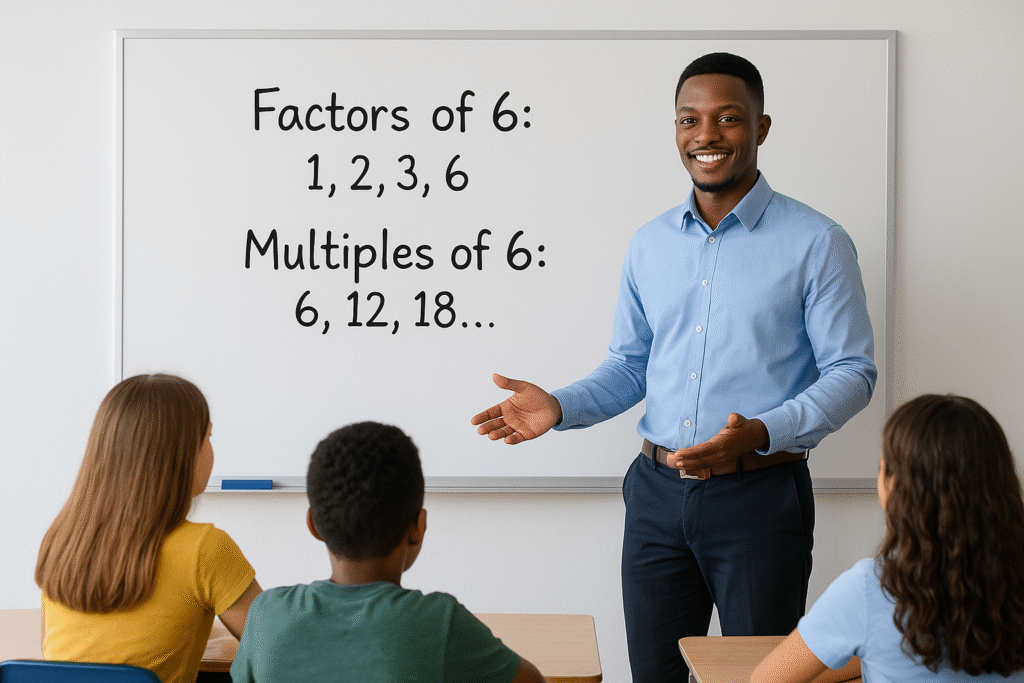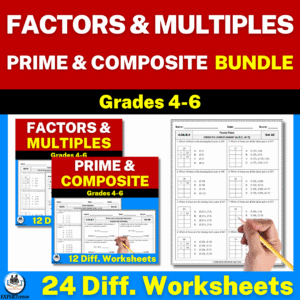
Factors and multiples are more than just math terms; they’re essential building blocks for number sense and problem-solving. In this post, we’ll explore how to teach factors and multiples effectively in upper elementary grades, with practical strategies, engaging activities, and ready-to-use classroom tools to strengthen student understanding.
Why Teaching Factors and Multiples Matter
Teaching factors and multiples is a vital step in building strong number sense in upper elementary students.
These concepts serve as the foundation for advanced math topics such as prime and composite numbers, greatest common factor (GCF), least common multiple (LCM), and fractions.
However, students often mix up factors and multiples — and that’s where intentional instruction, visual models, and plenty of practice come in.
Understanding Factors and Multiples
What Are Factors?
Factors are the numbers that divide evenly into another number.
In simpler terms, factors are the “building blocks” of a number.
For example, the factors of 12 are 1, 2, 3, 4, 6, and 12 because each of these divides 12 without a remainder.
When students understand factors, they strengthen their grasp of multiplication and division and begin to see how numbers connect in meaningful ways.
What Are Multiples?
Multiples are what you get when you multiply a number by whole numbers.
For instance, the multiples of 5 are 5, 10, 15, 20, and so on.
Recognizing multiples helps students develop skip-counting fluency and prepares them to identify patterns and relationships between numbers — skills that support more advanced topics like fractions and ratios later on.
Common Misconceptions
Even strong students can confuse factors and multiples.
Here are a few misconceptions you might notice:
- Students think factors are always smaller than the number.
- Students believe multiples “stop” after a few terms.
- Students confuse factor pairs with multiples.
To address these misconceptions, provide hands-on practice using arrays, visual models, and manipulatives.
These tools help students see that factors “fit into” a number, while multiples “extend from” it.
Engaging Ways to Teach Factors and Multiples
1. Using Factor Pairs
Teaching students to identify factor pairs helps them visualize multiplication relationships.
Encourage them to create factor t-charts or array models to see which pairs make a number.
For example, for 24:
1 × 24
2 × 12
3 × 8
4 × 6
This method helps students recognize patterns and symmetry in factor relationships.
2. Exploring Multiples with Patterns
Use number grids to highlight multiples and help students notice how they form predictable patterns.
For example:
- Multiples of 2 are always even.
- Multiples of 5 end in 0 or 5.
Let students color-code multiples to reveal overlapping sets — a perfect bridge to learning LCM later on.
3. Incorporating Games and Challenges
Math games bring excitement and repetition to practice. Try:
- Factor Bingo: Students mark off factors of given numbers.
- Multiple Match: Match numbers with their correct multiples.
- Factor Race: See who can find all the factors of a number first.
These activities make learning interactive while building fluency and accuracy.
4. Connecting Factors and Multiples
Have students use Venn diagrams to compare factors and multiples of two numbers.
This visual overlap helps them understand connections between GCF and LCM.
Riddles or mystery numbers also add fun, critical thinking challenges:
“I am a factor of 27 and a multiple of 3. I am greater than 5 and the square of another factor. What am I?”
Differentiated Practice for Every Learner
Not all students master these concepts at the same pace, so differentiation is key.
Use multiple-choice activities for guided practice and open-ended problems for students who need enrichment.
If you’re looking for structured, no-prep options, the Factors and Multiples Worksheets include both multiple-choice and open-ended formats.
This resource covers factors, multiples, factor pairs, and riddles, with built-in answer keys and data trackers to make grading and progress monitoring easy.
Try using these worksheets for:
- Morning work
- Math centers
- Homework review
- Quick assessments
Differentiated tools like these help you reinforce concepts while freeing up your time to focus on instruction.
Assessing Student Understanding
Formative assessment helps you identify misconceptions early and measure progress over time.
Here are a few quick options:
- Exit tickets after lessons.
- Mini quizzes on factor and multiple identification.
- Observation checklists during group work.
Tracking data over time allows you to adjust your instruction and celebrate growth.
Real-World Connections
Factors and multiples aren’t just classroom concepts — they appear everywhere!
Show students how they relate to:
- Team organization: Grouping players evenly.
- Art and design: Creating symmetrical patterns.
- Music: Repeating rhythmic beats (multiples).
- Cooking: Scaling recipes up or down using factors and multiples.
Real-life examples make these abstract ideas meaningful and memorable.
Final Thoughts
When students understand factors and multiples deeply, they unlock a new level of number sense and problem-solving ability.
By combining direct instruction, games, visual models, and differentiated practice, teachers can make these foundational concepts engaging and accessible to all learners.
Whether you’re reviewing for assessment or reinforcing skills throughout the year, no-prep, differentiated worksheets can make your math lessons smoother and more effective — while keeping your students confident and curious about numbers.
SAVE WITH THE BUNDLE (20% OFF)
-
Product on sale
 Original price was: $ 7.50.$ 6.00Current price is: $ 6.00.
Original price was: $ 7.50.$ 6.00Current price is: $ 6.00.



